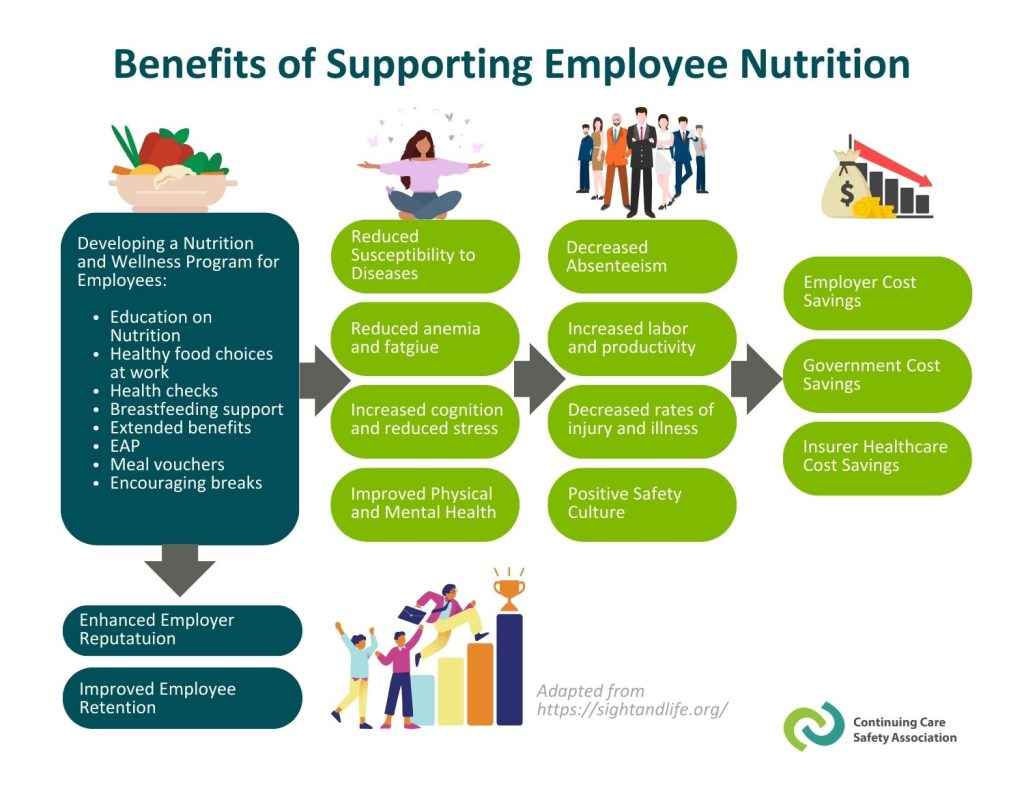
The Link Between Productivity and Food in the Workplace
Nutrition is an essential piece of employee well-being. Employers have a responsibility to keep their employee’s best interests in mind, and that includes talking about healthy food and healthy habits in the workplace.
Food for Health
Many Canadians want to make a positive contribution to their health and well-being. A good way to start is to make food and activity choices based on balance and moderation, and to handle food with safety in mind. We can eat very well, given the variety, safety, and wide availability of our foods today.
The Food for Health exhibition and website from the Canada Agriculture and Food Museum takes a fresh look at the foods we eat and answers many of the questions Canadians have about their food choices, about food safety and about the role food plays in ensuring good health.

Nutrition has a direct impact on the overall health and well-being of everyone in the workplace. Individuals with poor nutrition are prone to develop chronic diseases, and these, in turn, can negatively impact the quality of life and productivity at work. It can also put workers at a higher risk and susceptibility to infectious diseases. An unhealthy diet can lead to:
- Poorer mental health
- Increased stress levels
- Decreased energy levels
- A decline in cognitive ability
- Higher risk of chronic diseases
- Higher risk of obesity
Conversely, a healthy diet can promote employee wellness. Workers who eat well tend to have:
- Improved total health
- Higher productivity and morale
- Lower than average stress levels
- Lower absenteeism
- Less incidence of chronic disease
- More energy
- Better quality of life
Here are 5 tips for healthy eating by EWI works:
Workplace Wellness
According the Canadian Centre for Occupational Health and Safety (CCOHS), There is a strong connection between the health and well being of people and their work environments. When people feel valued, respected and satisfied in their jobs and work in safe, healthy environments, they are more likely to be more productive and committed to their work.
Employers should take time to develop workplace health strategies and ensure that all members of the organization has access to the tools and resources necessary for maintaining health and wellness in the workplace. Effective workplace health and well-being programs are tailored based on the unique needs of the workplace. Check out these common elements or area of focus that your workplace may want to take into consideration when formulating your wellness programs.
The following websites/resources provide helpful information to help your organization learn more about workplace wellness:
Related Topics
General Food Safety

Food Safety affects every Canadian and we all have a responsibility to ensure we do our part to prevent food borne illnesses from spreading in our communities. What is “food safety”? Food Safety refers to handling, preparing and storing food in a way to best reduce the risk individuals becoming sick from food borne illnesses. Follow four rules of safety
Clean — Wash hands and surfaces often.
Separate — Don’t cross-contaminate.
Cook — Cook to the right temperature.
Chill — Refrigerate promptly.
For more food safe tips and information check out the Government of Canada website.
Food Borne Illnesses & Outbreak
Every year, more than 4 million Canadians get food poisoning, also known as “food borne illness.” Protect yourself by learning about food poisoning, its symptoms and treatments, and how to avoid getting sick in the first place.
Over 11,500 hospitalizations and 240 deaths occur each year due to food-related illnesses.
Most types of food poisoning cause one or more of the following signs and symptoms:
- Nausea
- Vomiting
- Watery or bloody diarrhea
- Abdominal pain and cramps
- Fever
Most people fully recover, but foodborne illnesses can result in chronic health problems in up to 3% of cases, including chronic arthritis and kidney failure. Always follow the 4 rules: Clean, Separate, Cook and Chill!
For more information checkout Canada’s Food Inspection Agency (CFIA) website.
Nutrition for Seniors
People aged 65 and older are more vulnerable to food poisoning and other infections related to food-borne contaminants. The consequences of these food-borne illnesses are more severe and fatal for the elderly. Also, natural aging can alter a person’s nutritional requirements, as can medical conditions like high blood pressure or mobility issues. Alberta Health Services has a Nutrition Guideline Seniors Health Overview (65 Years and Older) made for health professionals.
Access resources to help keep seniors and their caregivers informed and safe! Canada’s Food Guide has information on portion control, eating habits, recipes and more. Make sure to check it out! Caregiver Stress has a great resource guide as well and SeniorsBC has a healthy eating for seniors guide, be sure to take a look.
